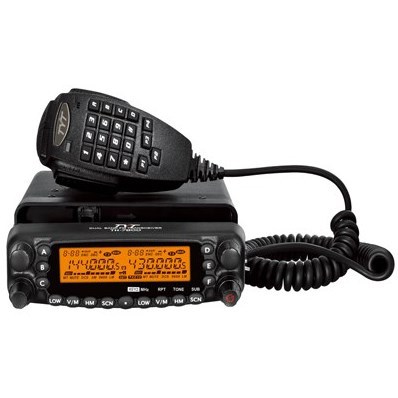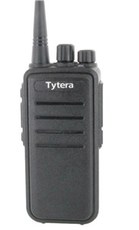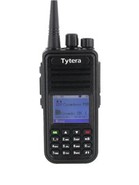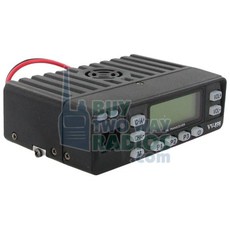 One look at the Leixen VV-898 and you can tell it isn't just another mobile radio. It's less than half the size of a conventional mobile two way radio and at just over 11 ounces, it's also lightweight, but don't let its tiny footprint fool you. This little radio packs a punch on both UHF and VHF bands with only 10W of operation. It's a solid solution for densely packed dashes. You can even install the VV-898 without drilling any holes. All things considered, the VV-898 is a great choice for those who want a small and discreet radio on the road or in vehicles in which installation of a full size mobile is difficult or out of the question.
One look at the Leixen VV-898 and you can tell it isn't just another mobile radio. It's less than half the size of a conventional mobile two way radio and at just over 11 ounces, it's also lightweight, but don't let its tiny footprint fool you. This little radio packs a punch on both UHF and VHF bands with only 10W of operation. It's a solid solution for densely packed dashes. You can even install the VV-898 without drilling any holes. All things considered, the VV-898 is a great choice for those who want a small and discreet radio on the road or in vehicles in which installation of a full size mobile is difficult or out of the question.
Sure, it's easy to put in your vehicle, but what can you do with it, and what can it do? Is it difficult to program? is it easy to operate? Let's take a closer look.
The Leixen VV-898 - what is it good for?
For starters, this little radio is handy for hams who cruise around town while on the local nets or a ragchew in the 2 meter (144-148MHz) or 70cm (420-450MHz) amateur radio bands. But that's not all it does. The Leixen VV-898 is also Part 90 type accepted as a full fledged business radio, which means businesses can also it as mobile transceiver or even a base station radio when connected to an AC power source and mounted to a wall or desk. The typical mobile business radio can cost hundreds each. Investing in the VV-898 for an entire mobile fleet can save a company a lot of money on two way communications. Type accepted for business use? Really? If you don't believe me, look it up. FCC ID: 2AC2Z-898UV.
Key features - what can it do?
Okay, so it's somewhat versatile and can be used in more than one radio service. But what can it do? Plenty. Although it may be light in weight, it is not light on features.
- Dual Band UHF/VHF transmit and receive
- 200-260MHz/87.5-108MHz (Receive Only)
- 4W/10W Transmit Power
- 199 Channels
- Voice Scramble - Configurable per channel
- Emergency Alarm
- Channel Scan
- Skip Channel
- Dual Watch
- Companding - Configurable per channel
- Busy Channel Lockout
- CTCSS/DCS Codes
- Backlit LCD Display
- Backlit Keypad
- User Customizable Power-On Display Message
- Power Save Feature (Auto Power Off)
- Timeout Timer
- VOX
- Keypad Lock
- English Voice Prompts
- Wireless Frequency Change (Wireless Cloning Capable)
- PC Programmable
- Built-in Speaker
- DTMF Code
- Supports 2.5k Step
- Reset
- Individual Call
- Group Call
- Remote TX/TX Inhibition
- Adjustable Squelch
- Adjustable Display Font Size (No kidding!)
- PTT ID - Send a code that IDs your transceiver
- Roger Beep Enable/Disable
- Reverse - Swaps out the offset frequency for simplex operation
- Tail Elimination
- Talk around
- Wideband/Narrowband operation
Programming the VV-898 - how difficult is it?
As with many mobile two way radios, the VV-898 can be programmed in one of two ways, either direct from the console and/or keypad, or through a computer via programming software. Let's take a quick look at both.
Direct from the radio
At first glance, programming the radio directly through the console seems complicated and foreboding, but not because there are a lot of buttons, knobs and dials, but because there aren't. In fact, there are no knobs or dials on this radio at all. There are only 9 buttons on the face of the radio itself, four of which are function keys, and a rather plain looking keypad on the hand microphone consisting of sixteen keys, four of which are labeled with the letters A, B, C, and D, respectively. Although the keys are marked, there is nothing intuitive at all about them in regards to actually programming the radio. In addition, the user manual, at only 55 pages, seems rather basic, providing the essentials of operation without much detail. In other words, the simplicity in design of the radio itself and within the pages of its user guide may give the user a sense it is a complicated device to program.
However, it isn't complicated at all. You just need to read the manual before you start, and not necessarily in page order. That is the key. You will also need to use the buttons on the console and the keypad on the hand microphone combined to do it efficiently. It takes longer at first, but once you understand the sequence needed to enter a frequency, assign it to a channel and save it to the radio, the entire procedure makes sense. I personally think setting up frequencies and channels on the VV-898 is easier than programming a Baofeng UV-5R, but then, so are many other radios.
The menu consists of 51 items. Default settings are bold.
| Menu # | Menu Item | Description | Option |
| 01 | Auto Power Off (APO) | Turns off radio after set time | 10 mins to 16 hours/OFF |
| 02 | APRO | Sets compander and voice scrambler
on per channel basis | ON/OFF |
| 03 | Busy Channel Lockout | Disables TX on active channel | ON/OFF |
| 04 | Key Beep | Beep when key is pressed | ON/OFF |
| 05 | Channel Save | Save frequency as memory channel | default channel is 001 |
| 06 | DTMF Function | Dual Tone Multi-Frequency settings
Individual Call
Group Call
Code Transmission Mode
Remote RX/TX Inhibition | Enable/Disable
ID Code 1000
A Enable/Disable |
| 07 | Dual Watch | monitor dual frequencies | ON/OFF |
| 08 | Decode Type | Set CTCSS/DCS | OFF/CTCSS/NDCS/IDCS |
| 09 | Decode Code | Choose CTCSS/DCS Code | NONE/Code # |
| 10 | Encode Type | Set CTCSS/DCS | OFF/CTCSS/NDCS/IDCS |
| 11 | Encode Code | Choose CTCSS/DCS Code | NONE/Code # |
| 12 | FM Radio | built-in broadcast receiver | ON/OFF |
| 13 | FM Scan | Scan FM radio channels | ON/OFF |
| 14 | FM SQL | Sets squelch for FM radio scan | 0-9/5 |
| 15 | FM Dual Watch | Listen to FM radio and RX simultaneously | ON/OFF |
| 16 | Font Size | Adjust display font | SMAL/BIG |
| 17 | Key Lock Function | Lock transceiver controls | ON/K/K+S/ALL/OFF |
| 18 | Keypad Function | Sets DTMF Keypad | ON/OFF |
| 19 | Backlight (Lamp) | Sets display backlight | OFF/KEY/CONT |
| 20 | Set Channel Name Display | Display channel name | ON/OFF |
| 21 | Channel Name Display | Choose name or number | ON/OFF |
| 22 | Edit Channel Name | Create name for channel | Name*** |
| 23 | Set Opening Display | Set power on display text | ALL/SYS/User/Time |
| 24-29 | Custom Keys Set | Define Programmable keys
P1, P3, P3, M | |
| 30 | High/Low Power Set | Sets transmit power | LOW/HIGH |
| 31 | PTT ID | Sends code to identify
your transceiver | ON/OFF |
| 32 | PTT SET | Sets PTT A and B | A=B/A!=B |
| 33 | Roger | Sends a "Roger Beep" | ON/OFF |
| 34 | Reverse | Swaps RX/TX frequencies for
to toggle simplex
and repeater operation | ON/OFF |
| 35-36 | Offset Frequency | Sets offset frequency | |
| 37 | Save Battery | Sets sleep mode option | ON/OFF |
| 38-40 | Scan Menus | Sets scan modes | TO/CO |
| 41 | Squelch Level | Sets Squelch Level | 0-9/2 |
| 42 | Step | Adjusts frequency step | 2.5/5/6.25/10/12.5
LOW/25KHz |
| 43 | Tail Elimination | noise burst at end of transmit | ON/OFF |
| 44 | Talk Around | Enables Talk Around | ON/OFF |
| 45 | Timeout Timer | sets TX timeout | 10-120 seconds/30 |
| 46 | TX Stop | Enables/disables transmitter | OFF/ON |
| 47-50 | VOX | Sets Voice Operated Transmit features | ON/OFF |
| 51 | Wide/Narrow Bandwidth Set | Sets channel bandwidth | WIDE/NARROW |
Programming with software
The VV-898 programming software is a lot more intuitive, of course, and generally easier than manually programming through the physical interface of the radio itself. Although the VV-898 does have a nice feature set, its full capabilities become more noticeable once you run the software. It's not complicated, but the software is more comprehensive and offers more programming options than you may expect from such tiny, simple looking radio. Considering its size and price, the VV-898 can do quite a lot more than just transmit and receive.
The USB programming cable is proprietary to this radio, so it isn't like you can mix and match them like you can with, say, Baofeng and Wouxun handheld transceivers. The programming software is also specific to the radio. However, the software is available as a free download, and for the most part it is self-explanatory, so unless you have never programmed a two way radio before, it should not be difficult to master. The USB cable driver needs to be installed, the programming software is available for Windows PCs only, and you do need a username and password to run the program, but once it's all set up, you are ready to program the radio. Oh, yes, in case you need it, the username is ham (all lower case) and the password is 89812345.
Operation - is it easy?
Once programmed, the VV-898 is fairly simple to operate. To turn it on, simply hold the power button down for a second or two, and release. Use the CHA+ and CHA- buttons on the console (or the * and # buttons on the hand mic) to change channels, adjust volume with the VOX+ and VOL- buttons on the console (or the UP and DN buttons on the side and top of the hand mic), and of course, the PTT on the mic to transmit, and your pretty much good to go. There are three buttons on the console that are user programmable to your needs. The A, B, C, and D buttons on the hand mic are preset for functions according the the chart below:
| Button | Operation |
| A | Call |
| B | VFO/MR Switch |
| C | A/B Mode Switch |
| D | VFO Band Switch |
The Leixen VV-898 seems like a plain, low power, unimpressive little radio, but it really does have a lot to offer. Is it a 125W PEP powerhouse Icom mobile or a feature rich Wouxun KG-UV920P-A? Of course not! Considering its small size, weight and unassuming looks, when you take a closer look at the Leixen VV-898, in some ways it seems even better.
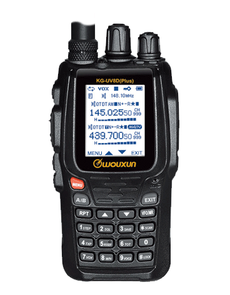 The KG-UV8D is one of the most popular Wouxun handheld transceivers on the market, and with good reason. It has a crisp, color LCD display that dwarfs the screen of other analog radios in its class, it's loaded with powerful features found on high end amateur radios, and it's very reasonably priced. Not only that, on a local ragchew, it's just plain fun. Now, Wouxun has released a new iteration of the 8D to market that adds even more to the mix: The KG-UV8D Plus.
The KG-UV8D is one of the most popular Wouxun handheld transceivers on the market, and with good reason. It has a crisp, color LCD display that dwarfs the screen of other analog radios in its class, it's loaded with powerful features found on high end amateur radios, and it's very reasonably priced. Not only that, on a local ragchew, it's just plain fun. Now, Wouxun has released a new iteration of the 8D to market that adds even more to the mix: The KG-UV8D Plus.




